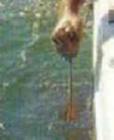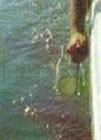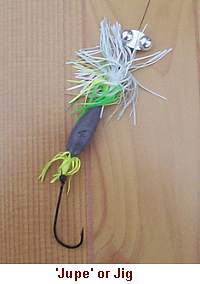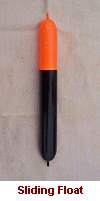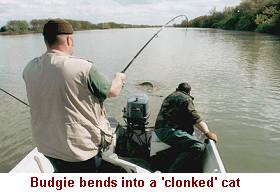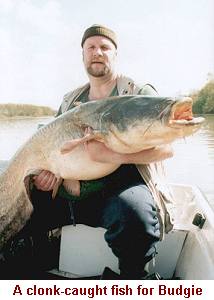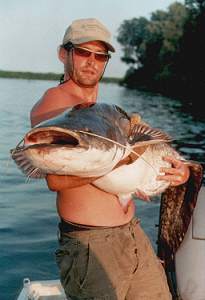Whooomp! Whooomp! The deep resounding thud of the clonk hitting the water echoed off the tree-lined bank. On a good hit the very hull of the boat could be felt vibrating. I carefully watched the screen of the Hummingbird sonar, and adjusted the depth my bait, a live eel, was fishing at. Suddenly a ‘piece of the bottom’ broke away and headed towards my bait clearly shown on the screen. Seconds later the braid was savagely pulled from my hand and the float pulled downwards by some unseen monster. . . . . 
This is a typical moment in a day afloat ‘clonking’. So what the hell is Budgie talking about this time? The clonk, or as it is called in some parts of Europe, the Butchelo, is a specially-shaped piece of wood. When the surface of the water is struck in the correct manner the clonk produces a deep resounding sound. This in itself takes some time to master, early efforts sounding like rather enthusiastic tea stirring! Once you have mastered the art and can consistently make the correct sound all you have to do is then build up some stamina so you can do it all day. After a complete season spent clonking you build up a right arm like Popeye! (Well that’s my excuse and I am sticking to it). So why go to all this trouble? Where the clonk has not been used too much it can be an absolutely devastating method. It works best on otherwise lethargic fish, which can be drawn up from their slumber on the riverbed. Even if they don’t take your bait they will still be stirred by the call of the clonk. Why it works I don’t know. Some say that the noise represents small food fish splashing on the surface, I think it sounds more like my granny farting in the bath! Whatever the fish think it certainly raises their curiosity. The well known French cat angler Olivier Portrat claims to be able to raise fish just by stomping on the hull of his boat! When it has been used a lot it seems to lose its effectiveness. Maybe the cats start to associate it with danger rather than food? I don’t know. Incidentally, it pays to practise your clonking before you use it in a fishing situation. Poor clonking can actually put the cats down and greatly speed up the wising-up process. So how do we tackle up and fish with this tool? For all of my boat work for cats (other than lure fishing) I use a 10′, 6lb TC carbon rod made for European Catfish Trips by a German firm. We are still not 100% happy with this rod but it is as close as we have come yet. As with all my cat rods it has a through-action. Luke Moffat was the major influence in the design of this rod and as all of his guiding is now done from the boat who better to do so? Brian Potter at Bruce & Walker is currently experimenting with various materials for the Mk 2 version. The reels used are our normal cat reels, the Shimano 6500 Sea Spins. These are always loaded up with braid, 30kg being about right. Any reputable make suffices but it is handy to have it white in colour for reasons I shall explain later. There are two main methods used with the clonk, a jig, or teaser set-up, used in conjunction with lobworms and the livebait approach. Both are fished very similarly but in my opinion the livebait approach works best. The tackle set-up for this consists of a 6/0 Maruto hook, a hook length of ‘Ton up’ (the new big cat braid from Kryston, reviewed for the first time on this web site – see link below) an inline lead (4ozs-plus depending on depth) and an 11in sliding cigar float. Just a very heavy sliding float rig really. But why so heavy you ask? Several reasons really, but they all add up to the same thing: better, more positive control and presentation of your bait. Remember that on some rivers (the Po being a good example) you can be fishing over 50ft deep in a fast current. The best bait by far is a live eel. If hooked carefully near the tail they work very hard and last well on this sort of rig. Believe it or not they are less tangle-prone than most other baits! Once out in the boat the sliding float stop is adjusted to fish the bait at the required depth. This is where the white coloured braid comes in. Prior to fishing the braid is marked with a waterproof marker pen in 1in divisions with an extra mark at every 10ft interval. This enables you to know exactly what depth the float is set. The bait can be set at whatever distance from the bottom you fancy (if there are a couple of you in the boat it pays to all set up at different depths until a pattern emerges). When all floats are set (you can only effectively clonk with one rod per person) you can start drifting down the river at the pace of the current. I normally have an electric motor as well as the main outboard; this is used to control the drift. You can drift over a set feature that you have found or just drift as far as you want to. The rods are upright in rests with either the bale-arm open or the baitrunner on. The anglers hold the line just above the float keeping it tight along side the boat…. ‘Oy Fatty – no! Even though we respect your catfishing skills, when it comes to this clonking lark we say Budgie no!’ I can hear you now, but I kid you not, this is no wind-up. I am deadly serious. Whilst you are drifting along I will be constantly watching the depth-finder, calling out any changes so that the others can quickly adjust their floats thereby maintaining the same distance from the bottom. I am also watching for signs of cats lifting off the bottom to have a look at the bait. It is more like playing a computer game than fishing! The most important thing though is that I will be constantly striking the waters surface with the clonk hopefully making the correct sound to raise the cats. The only time I will pause is to adjust my own float. So why am I so sure that it is the clonk that attracts them and not just a coincidence? In the early days we were very sceptical so we conducted several tests. Too many times we would drift down silently without a take only to do the same drift again with the clonk and catch for it to be a coincidence. Also it is inevitably the bait that is directly under the clonk at the time that is taken. This can vary from angler to angler due to current speed, angle of drift etc. When a cat takes you just let go of the line, pick up the rod and treat it like any normal take. I have used this method on all of the major European cat rivers. If you can find an area where it hasn’t been used much before it is devastating. |
Welcome!Log into your account










